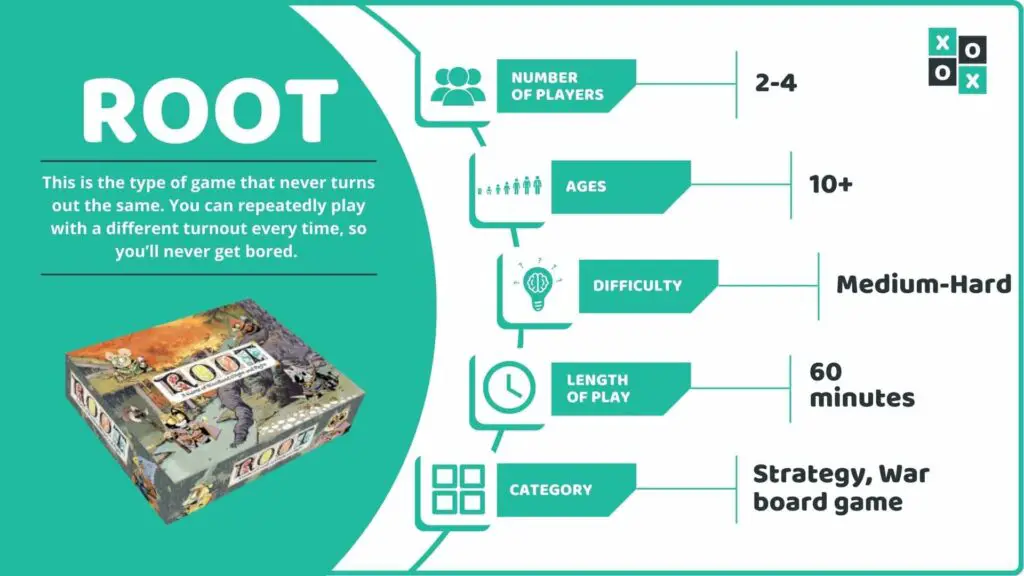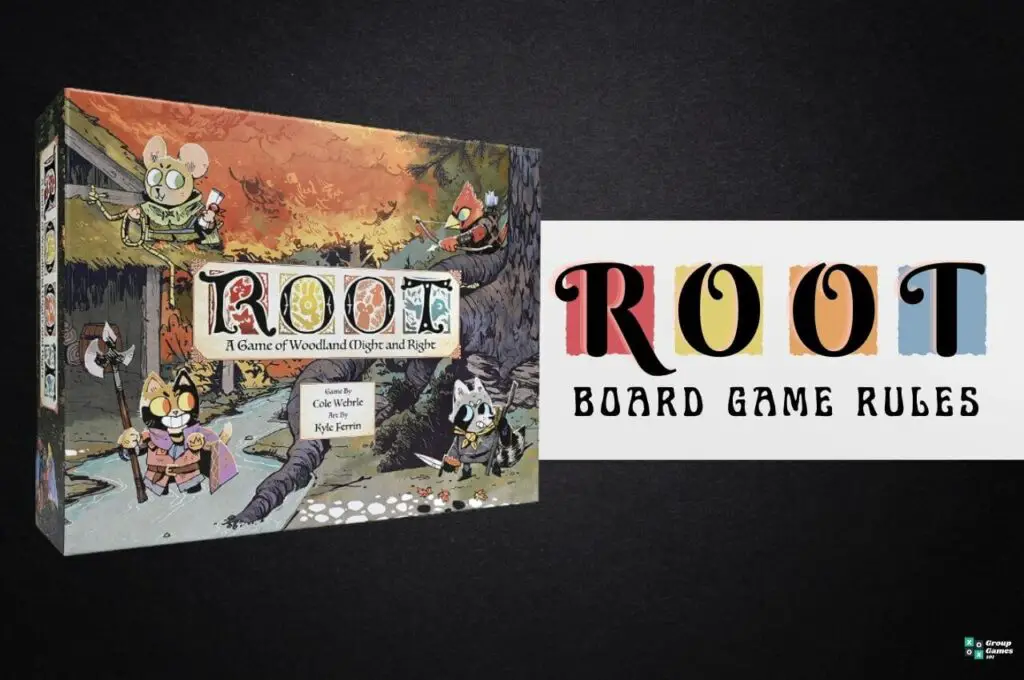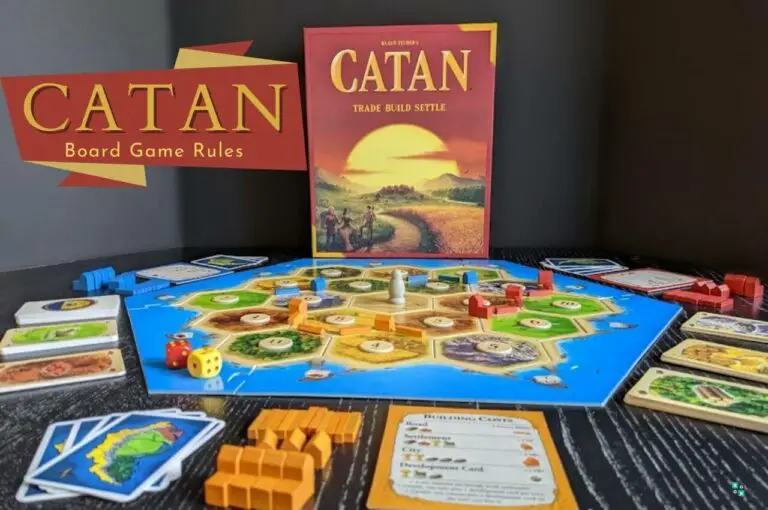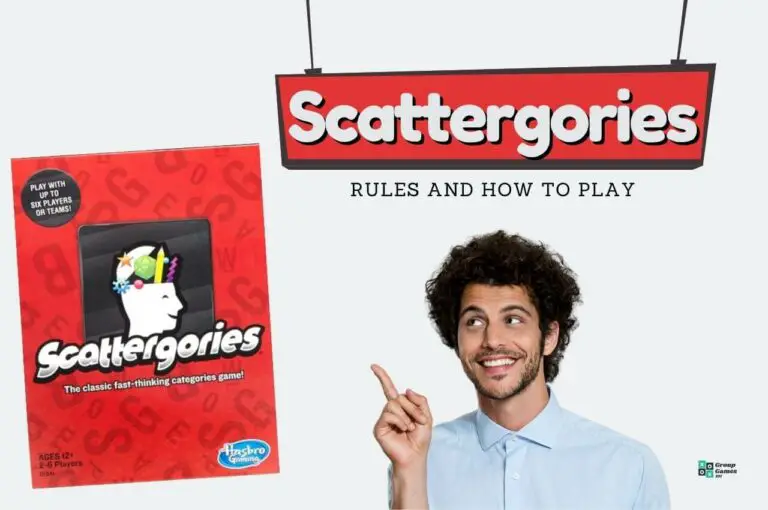Do you have what it takes to be the most righteous ruler of the vast woodland? Root is a multifaceted game of adventure and war. If you are ready for the journey, read on to discover the clear Root rules and gameplay.
This award-winning game has been recognized internationally for both its design and production.
In 2019, Root won People’s Choice and the Judge’s award for the UK Games Expo Best Board Game strategy category.
This Root rules guide will cover the following:
- What is Root?
- A brief history of Root
- What you’ll need to play Root
- Root rules
- How to play Root (Video Tutorial)
- FAQs
Read on to learn how to play Root the board game.
What is Root?

Produced by Ledger Games, Root is an adventurous thematic war game for up to four players. The game occurs in autumn or winter while players fight to claim power over a vast woodland territory. This game always ends differently, keeping it entertaining play after play.
Number of Players: 2-4 players
Ages: 10+
Difficulty: Medium-Complex
Length of Play: 1 hour
Category: Strategy, Wargames
Similar to: Everdell, Risk, Wingspan
Main Objective: In this wargame, players battle to obtain control over a vast woodland. The first to earn 30 points is the new ruler.
Why We Love It: This is the type of game that never turns out the same. You can repeatedly play with a different turnout every time, so you’ll never get bored.
A Brief History of Root
Produced by Ledger Games, Root was released in 2018 and has received multiple international awards. Founded in 2014, Ledger Games is known for creating well-composed and detail-oriented games that award repeat gameplay.
Root has a variety of expansions available today, including Root: The Clockwork Expansion, Root: The Riverfolk Expansion, and Root: The Underworld Expansion.
What You’ll Need to Play Root
Everything you need to play is included in this boxed set.
The complete game box contains:
- 1 rule book
- 1 board (Fall and Winter maps)
- 2 dice
- 4 fraction boards
- 28 buildings
- 19 tokens
- 12 clearing markers
- 4 ruins
- 4 victory point markers
- 3 relationship markers
- 23 items
- 55 warriors
- 1 vagabond pawn
- 54 cards (shared deck)
- 16 fraction overviews
- 4 Eyrie leaders
- 2 loyal Viziers
- 3 vagabond characters
- 15 quests
- 4 walkthroughs
Area of Play
To begin setup, each player selects a faction and collects the faction board, including all the pieces listed on the back of the board and the faction’s walkthrough card.
Players need to sit in the following clockwise order: Marquise, Eyrie, Alliance, Vagabond. Every player follows the steps listed on their walkthrough card, keeping their cards visible.
- Begin by using the autumn side of the map.
- Set all scores on the score track to position “0”.
- Shuffle the remaining 39 cards to form a shared deck.
- Set the four ruin markers on the four spaces labeled with “R” on the map. They are hidden under ruin tokens.
- Place the 12 items on the specified positions on the top of the map.
Starting the Game
Deal three cards to all players, and decide who will go first.
Each faction operates a little bit differently. All players will follow the same primary phases: Birdsong, Daylight, and Evening.
During the Birdsong phase, players complete most of their specific tasks according to their faction.
Root Rules
Take as many warriors as you want and move them to an open clearing. To leave a space, you must be the ruler of that territory or rule the clearing you are moving.
The ruler is determined as the player with the most warriors and buildings in any area.
For example, if you move three of your warriors to a location with only one opposing warrior, you will now be in control of the clearing. The opposing warrior can leave the area on their turn if they are going into a space they already rule or will rule.
Battle
If you do not want an opposing warrior to leave the area, it is time for battle!
The attacker will roll the 12-sided dice for this action. Each die has numbers ranging from 0-to 3 listed on it. The roll of the dice determines how many hits each side will obtain.
The attacker claims the higher number rolled. If the dice land on 1 and 3, the attacker takes 3.
The maximum damage totals the number of warriors. If there is only one warrior in the battle, both sides lose one warrior, leaving the remaining damage unused.
Clearing
If the clearing is built up with resources, the defender would be able to destroy the opposing warrior, but they would also be able to claim some of the resources left on the property.
You cannot claim any buildings or tokens from a clearing until the warriors have died.
Sometimes a card may allow you to deal more hits than your opponent’s number of warriors. If the area has no warriors, the attacker automatically takes an extra hit from the number they rolled.
Cards
Cards are all categorized by one of the following four suits: Foxes, Rabbits, Mice, or Birds, as shown on the icon on the upper left-hand corner of each card.
Foxes, Rabbits, and Mice are associated with the clearings on the board; however, birds are considered wild since they can fly.
The symbols shown on the signpost on the lower-left corner of a card explain the requirements needed to craft a card. For example, “two rabbits.” You may need to use these cards based on a specific action, but there are times when you can craft a card.
Beware, the suit of the card and the suit of the signpost requirements may not match, so be mindful when considering the items needed to craft a card.
Card Benefits
- Cards with a yellow background indicate an immediate benefit earned from the card. In this case, resolve the effect immediately, then discard the card.
If the card allows you to take an item from the top of the game board, you can take it and place it on the top of your player board. If the item is not available, you cannot claim it. Score however many points are listed on the card for this action, discard the card.
- Cards with a blue background indicate a persistent benefit. In this case, place it near your board. You can have many persistence cards, as long as they are not multiples of the same card.
Different factions activate different game pieces during gameplay, but you can only use one per turn.
Ambush! Cards
Ambush and Dominance cards do not need to be crafted.
A defender can reveal an Ambush card at the beginning of a battle if the suit matches the battle’s clearing. This action places two hits on the attacker, killing two of their warriors.
If this action destroys all the opposing warriors, the battle ends. However, if the attacker plays a matching Ambush card, it cancels out the original Ambush.
Dominance Cards
Dominance cards can only be used in 3+ player games.
You can play a Dominance card if you have at least 10 points on the scoreboard. This allows you to remove your score tracker from the board and place it on the Dominance card. This opens up more possibilities for winning.
The Dominance card will state the specific considerations, and you cannot win on the same turn in which you play your Dominance card.
If you want to discard a Dominance card instead of using it, place it on the side of the board so another player can claim it if desired.
To take an available Dominance card, first, you must discard a card that matches the suit of the Dominance card during your Daylight phase. Then, you can take the available Dominance card.
Winter Board
It is best to begin playing this game using the autumn side of the board, but when you are more experienced, try playing the winter map located on the reverse side of the game board.
The paths on the winter map are different, and before playing, you will randomly assign suits to each clearance. Otherwise, the gameplay follows the same basic rules.
Marquise de Cat
The goal of the cat faction is to turn the woodlands into an industrial machine.
If you are playing this position, your letter is A, so you can decide where to place your keep. You are in the most powerful position, so choose a corner clearance on the side of the board with multiple buildings.
Next, place one warrior in every clearing except the opposite corner. Then, play one of your buildings in the clearings containing and next to your keep.
Finally, flip over your faction board and place all of your remaining buildings for future use.
Tip:
For beginners playing Root, the cat faction makes a great beginning player because their actions are generally recognizable from a strategy standpoint.
Birdsong
During the Birdsong phase, each sawmill creates a woodpile. Place the wood stack token beside each sawmill during this phase. You will use these later for building.
Daylight
During Daylight, you can craft items from a card in your hand to activate workshops in your clearings, ultimately earning you points.
Example: If you have the Root Tea card and wish to make tea, you must have the workshop in the specified clearing depicted by the symbol on the lower left hand of the card.
Simply take the required item from the top of the board, place it on the crafted item section on your faction card, then claim the points for completing the action.
Next, you can select three actions: Battle, March, Build, Recruit, Overwork. You can discard bird tokens for each extra action you wish to take.
Battle: Start a fight with your warriors and an opposing warrior on the game board by rolling the dice.
March: This allows you to move your warrior two clearings in a row. You can move your warrior two clearings in a row. Complete both moves before moving on to complete another action.
Recruit: When recruiting, you can place up to one warrior at each recruiter. Each recruiter allows you to build armies more quickly. You can only recruit once per turn.
Build: This is the best way the cat earns points. You can use the wood from the sawmill to help you complete specific tasks such as Gross or breeding new kittens.
The cost of each action is defined in the Buildings section of your board. For instance, to breed new kittens, you need to spend one recruiter token.
You gain the points listed on the board space when you build something under the tile you remove. Also, when you build, trace an undefined line from the wood to the new build site.
This action gets more complex as the game evolves and the cat loses control over more territory.
Overwork: This action requires spending one wood in a matching clearing with a sawmill.
Evening
During this time, draw one card, plus one for each token showing on your player board. After drawing, discard down to five cards if you have more than five cards. Your turn is over, and the next player begins their turn.
The cat has two special rules:
Other players cannot place any game pieces (warriors, tokens, etc.) in the cat’s clearing on the board. They can move items into the space, but they are taking a risk that they might get destroyed and can’t be rebuilt.
You can use a Field Hospital card to save warriors from an attack by moving them into your keep to safety. Just spend the card that matches the clearing they were in to complete this action.
Eyrie Dynasties
Before the cats took over, the Eyrie Dynasties ruled the land. They seek to reclaim their territory, but you’ll need to rebuild their presence in the forest to do this.
The Eyrie Dynasties represent the birds, and they are listed as “B,” so their setup begins after the cats.
To start, claim the corner opposite the keep, and place one roost to mark your territory. Place 6 warriors on your roost, and select one of the following birds to serve as a leader: Charismatic, Commander, Builder, or Despot.
Each leader’s card explains the position they take in the game. Place the leader on your game card and place the other bird cards in their designated slots on top of your board.
The decree is significant for the birds because it determines the actions you must take.
Birdsong
If you have zero cards in your hand, draw one card to begin your turn.
In any available space, add one or two cards to your decree. Look at the suits of each card to determine where the actions can take place.
Birds are wild so they can count as any space, but if you have another suit, such as the rabbit, it will be limited to a specific area. When adding cards to your board, only one can be a bird.
If you have no roost by this time, go ahead and place a roost on any clearing with minimal opposing warriors.
Daylight
Begin by crafting using your roost. It is during Daylight when the Decree takes shape. If you only have one roost, you can only craft one item using a card with a matching symbol.
The decree must take flight by taking action for each card placed at the top of your board. If you have a card shown in the Recruit section, start by looking at your leader’s card to determine how many warriors you can place in your roost on the game board.
Next, look at the card shown in your Move category and move away from the suit listed. For example, if the card is a Rabbit, you must move warriors from the Rabbit territory on the map.
You must conduct a battle in the clearing listed based on the card’s suit. You don’t have to win the battle. You can lead the battle in any clearing if you have a bird suit.
You must complete the build space on your decree. Unlike the cats, you don’t have to spend resources to build. To build, place a roost on a clearing you control that matches the suit shown on the decree card.
Decree Card
At the start of the game, your decree may only have four cards, but as the game evolves, your decree can contain many different cards in each of the four slots. This becomes more challenging.
You can use your cards in any order within each column, but if you cannot complete an action for one of the decrees, you will go into Turmoil.
Turmoil is a problem. Here are the four steps:
- Your king is humiliated because you could not complete the decree. You lose 1 point for each bird card in that decree. Including Viziers, it will always be at least 2 points lost.
- You must purge your decree by discarding every card except Viziers.
- Your leader is now deposed. Flip over the leader card, choose another leader card, and reassign any Viziers to their new post.
- Finally, you must rest. This concludes your Daylight phase.
Evening
Now, look at the roost track on your board to determine how many points you’ve earned—the number below the highest space. The more roosts you can play on the board, you’ll earn more points!
Then, draw one card plus a card for each card symbol earned on your roost track. Lastly, discard down until you only have five cards.
Special Rules:
- Lords of the Forest: The birds rule in any clearing where they are tied in presence.
- Disdain for Trade: Regardless of the points listed on the craft card, when birds craft an item, they can only claim one point.
Woodland Alliance
The smaller animals of the forest work together to build an alliance and sympathy. From this position, obtaining supporters is the best way to make sympathy, thus earning points.
First, draw three cards and place them face-down on the designated Supporter’s place on your faction card. You can look at them, but no one else should be able to see them at this time.
Birdsong
During this playing stage, you can play either of the two following actions as many times as you want:
- Spread Sympathy: If you want to make a clearing sympathetic to your cause, you’ll have to spend two sympathy cards that match the suit of the clearing to place your sympathy token in that area of the map.
Check the Sympathy section on your card to see how many points you earn per token placed. The first sympathy token can go on any clearing, but your must place subsequent tokens on clearing adjacent to an existing token.
If there are three or more warriors in a clearing, you must spend an extra sympathy card to obtain sympathy there. You can only place one sympathy token per clearing.
- Revolt: Place two supporters matching the suit of a sympathetic clearing and an unbuilt space to start a revolt. Next, you can remove all enemy tokens, except vagabonds.
Now, place a base token down on the clearing along with warriors matching the number of sympathies you have established in matching clearings.
Finally, place one warrior token on your board in the Officer’s place.
Once you have set up a base, be sure to protect it, or else you will have to lose your supporters and officers.
Daylight
The Daylight phase consists of three actions that you can complete as many times as possible.
- Craft: Using your specific sympathies, you can craft various card actions based on the card’s requirements.
- Mobilize: Add a card from your hand to your deck of supporters.
- Train: You can spend a card from your hand that matches the card’s suit on the Base of your faction card to place a warrior in the officer’s section.
Evening
First, you can complete military operations such as Move, Recruit, Organize, or Battle. They can be completed in any order, but you must have one officer for each.
Next, draw one card, plus one for each plus sign image visible on the Base section of your board, then discard any additional cards exceeding five.
Lastly, there are several special considerations, including Outrage, which states that if anyone removes sympathy from your clearing, they have to give you a card matching the suit of the clearing.
If they do not have a matching card to give you, your opponent must show you their hand, and then you can draw a card from the deck to add to your supporter’s deck.
Guerilla War is the second unique condition because you can always take the higher roll of the dice when engaged in a battle.
Vagabond
The Vagabond is an unusual character who wanders to the beat of its drum, making friends and enemies along the way. Beginning game set up and play; the Vagabond is last to start.
First, choose a character from the following three options: Tinker, Thief, or Ranger, and place the card on your player board. Grab the Starting items, represented with the letter “S” shown on the bottom of the card. Flip the item tokens over in your Satchel when you use them.
Now, put your pawn on any forest on the map, shuffle your Quest Deck, and place it near the game board.
Finally, place the relationship tokens that match every other player’s faction, positioning them on the Indifferent section of your player card.
Special Rules:
The Vagabond can move in and out of clearings without concern for ruling warriors. As a vagabond, you are a lone wanderer, not a warrior, so you cannot rule any clearings. No matter what, another player cannot remove your piece from the game board.
Birdsong
- Begin the round by refreshing two of the items in your Satchel by flipping them back over. You can flip over two additional items per tea that you own that have not been damaged or exhausted.
- Then, you can Slip, or move, into an adjacent forest or clearing on the map. Unlike the autumn map, if you are playing on the winter board, rivers separate clearings.
Daylight
Use all of your items to complete actions, such as using your Boots to move across clearings.
When fighting, the maximum number of hits you can take depends on how many unused swords you possess.
If you are the victim of a hit, you will have to move items to the Damaged section of your board, and you cannot use them until they are repaired.
If all your swords are damaged, you are defenseless, which means that enemies gain an extra point to attack you.
After removing warriors from clearings, use the cross-bow item to destroy buildings or tokens.
The torch item can be used for your character’s special ability listed on the card or to take an item from a ruin in your clearing. Collect the item and remove the ruin token from the map, leaving it open for future use.
Earn points for removing ruins, and be sure to move your marker along the score token at the bottom of the game board.
Use hammers to repair broken items. Hammers are also used to craft cards as long as the hammer matches the clearing and meets the requirements.
As a vagabond, you can purchase items crafted by other players for cards. You will give them a card matching your clearing and exhaust any item available to take any one of their items.
By doing this, you will also earn points by moving your marker up on the Relationship board.
It will cost you cards, but you will earn points. You don’t have to take any items either. However, you will need to aide your allies several times per turn in order to continue earning points.
Allies: When you build your relationship with an opponent to the point where you become allies, you will earn two points every time you help them.
As allies, the vagabond can also carry warriors through clearings with him, as long as they stay on the paths.
You can add your ally’s hits to your max hits when you initiate a battle! However, if they take more hits than you, you can no longer remain allies and become hostile. This can also happen if you remove pieces from your opponent’s clearings.
You can earn points for removing an opponent’s piece during a battle; however, when traveling into a clearing with hostile warriors present, you must use an additional boot.
Questing: If you are in a clearing that matches the suit of a Quest card, you can use the matching items to complete the quest.
For each quest completed in a specific suit, you can earn a point or draw two cards. There are five cards per suit, so this is a great way to achieve multiple points.
Evening
After completing as many actions as possible, you can start the Evening phase. If you are located in the forest, you can repair all your items.
Next, draw one card, plus one card for each stack of coins, then discard down to five.
You are also limited to six items total, so discard any additional items exceeding six. However, if you have bags available, you can hold additional items.
For the vagabond, dominance cards are claimed by forming a coalition with another faction. In a game of four or more players, choose a dominance card. Place your score tracker on the player board with the fewest points besides you.
If that player was hostile, they now could move up to Indifferent. Now, the vagabond shares the victory with any wins earned by the teaming faction.
How to Keep Score in Root
Players earn points anytime they force a player to remove a token or building from their territory.
Each of the four factions earns points by completing various actions throughout the game.
All players monitor their scores by moving their tokens along the score tracker shown at the bottom of the map.
Ultimately, the first player to earn 30 points is the winner and becomes the new ruler of the vast woodlands.
How to Play Root – Video Tutorial
Frequently Asked Questions
Is Root a good game?
Root has been nominated for multiple awards worldwide. Gamers enjoy playing Root, and with the available expansion packs, there are even more opportunities for gameplay. Root is complex and requires some time to learn the rules, but overall it is a good game.
How long does the game Root take?
The game of Root typically takes between 60 and 90 minutes to play. Root’s playing time can vary depending on the number of players or the expansion packs utilized.
Is Root good with 2 players?
To enjoy the complete experience of Root, four players each manage a specific unit, each with very different playing specifications. One recommendation is for both players to complete two factions each, one at a time, so that you can experience the full game potential.
The expansion packs allow for groups of up to six players, so if you have a larger playing party, check out some of the available expansions.
Other Games Similar to Root (Our Guides)
After playing Root, check out these similarly thematic wars and adventurous worker placement games.
- Lords of Waterdeep Rules
- Risk Board Game Rules
- Oath (Guide coming soon)
- Everdell Rules
- Vast: Crystal Caverns (Guide coming soon)








